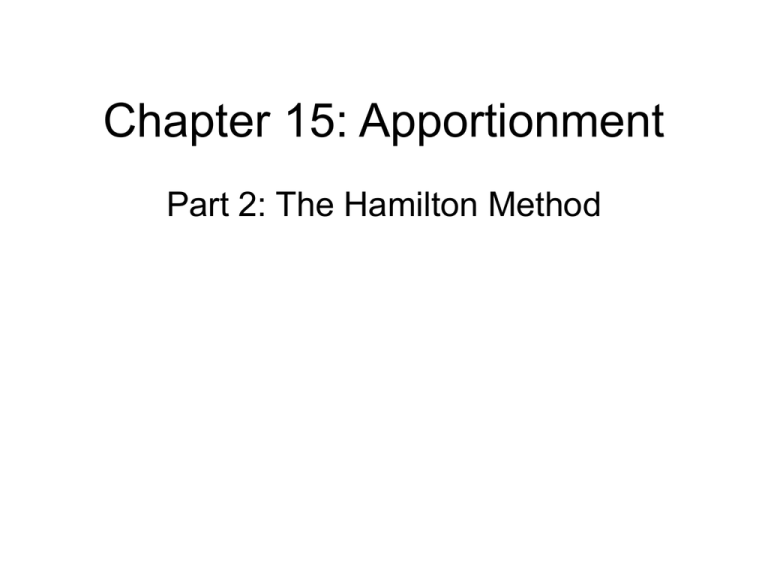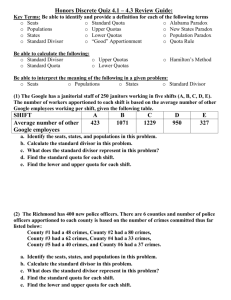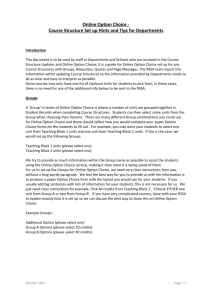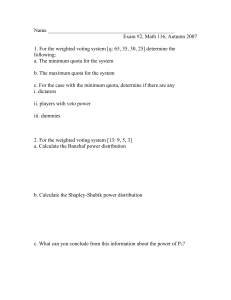Hamilton's Method
advertisement

Chapter 15: Apportionment Part 2: The Hamilton Method The Hamilton Method • The Hamilton Method, one of several methods of apportionment we study, is named after Alexander Hamilton. It was first used to decide the initial apportionment of the seats in the House of Representatives in 1790. That apportionment was vetoed by George Washington and the House was reapportioned that year according to the Jefferson Method. The Hamilton Method did come back into use in 1850 and was then used until 1900. • To explain this and other methods, we must define certain terms… • There are problems of apportionment other than those involving the House of Representatives but because apportionment of the House has been so historically significant to the development of these methods in general, the terms we use reflect that connection. The Hamilton Method • Suppose the total population of all states is p and that are there are h seats in the house (we call h the house size). That is, house size is the total number of seats available. • We define the standard divisor, s, as follows: total population standard divisor house size or p s h The Hamilton Method • Next, we define the term quota as follows: population of state i quota standard divisor or pi q s • Thus, each state could have a different quota. • In the case of apportioning seats in the House of Representatives, the quota is the number of seats that a state would get if they could have a fractional part of a seat. That is, it is a fractional part of the whole before being rounded to an integer. The Hamilton Method • By definition, population of state i quota standard divisor and total population standard divisor . house size That is, pi q s and p s . h pi pi h pi q h. p 1 p p h Therefore, Conclusion: pi q h p The Hamilton Method Notice that because of the conclusion pi q h p we can calculate a state’s quota without actually using the standard divisor. This is what was done in a previous example… Suppose house size is 200, Alabama has a population of 940 and the total population is 20,000. Then h = 200, pi=940 and p = 20,000. Thus, to find Alabama’s quota q 940 200 0.047200 9.4 seats 20,000 The question then becomes, how do we deal with the fraction of a seat? The Hamilton Method • For the Hamilton method we will also need the following definitions: • The lower quota, which is denoted by q , is the value that results from rounding down the quota to the next lowest integer • The upper quota, which is denoted by q , is the value that results from rounding up the quota to the next highest integer. • If q is an integer, then done. q = q = q . That is, no rounding is The Hamilton Method • The Hamilton Method of apportionment is as follows: 1. 2. 3. • Calculate each state’s quota. Temporarily assign each state it’s lower quota. Starting with state’s having the largest fractional part in their original quota, distribute any remaining seats, in order from largest to smallest, until all remaining seats are distributed. The Hamilton Method does not specify what to do in the case of a tie – if two states had the same fractional part in their quota - but this is unlikely to occur. Example #1 - The Hamilton Method • Consider a country with 4 states and 30 seats in a congress and populations distributed as in the table below. Population State A 275 State B 383 State C 465 State D 767 Total 1890 Example #1 - The Hamilton Method • Consider a country with 4 states and 30 seats in a congress and populations distributed as in the table below. Population State A 275 State B 383 State C 465 State D 767 Total 1890 We find the standard divisor to be 1890/30 = 63 Example #1 - The Hamilton Method • Consider a country with 4 states and 30 seats in a congress and populations distributed as in the table below. Population Quota Quota Lower quota State A 275 275/63 4.37 4 State B 383 383/63 6.08 6 State C 465 465/63 7.38 7 State D 767 767/63 12.17 12 Total 1890 30 29 Add remaining seat +1 Example #1 - The Hamilton Method • Consider a country with 4 states and 30 seats in a congress and populations distributed as in the table below. State A Population Quota Quota Lower quota 275 275/63 4.37 4 State B 383 383/63 6.08 6 State C 465 465/63 7.38 7 State D 767 767/63 12.17 12 Total 1890 30 29 Add remaining seat State C has the largest fractional part +1 Example #1 - The Hamilton Method • Consider a country with 4 states and 30 seats in a congress and populations distributed as in the table below. Population Quota Quota Lower quota Add remaining seat State A 275 275/63 4.37 4 4 State B 383 383/63 6.08 6 6 State C 465 465/63 7.38 7 State D 767 767/63 12.17 12 12 Total 1890 30 29 30 +1 Final apportionment 8 Example 2: The Hamilton Method • Let’s use the Hamilton Method to apportion students into classes. • Suppose a high-school math teacher can teach a maximum of five classes in one day. Suppose that she teaches geometry, precalculus and calculus. Suppose that 52 students registered for geometry, 33 for pre-calc and 15 for calculus. • How many of each class should the teacher be assigned? • We have a total population of students: 52+33+15 = 100 students. These 100 students are divided among 3 subjects. We are also dividing the 5 classes among the 3 subjects. Example 2: The Hamilton Method • We can look at these apportionment problems in terms of groups and items. There are several groups, like states which have different populations and there are items, like seats to be divided among those groups, based on the populations. • Here we have 3 groups, in this case the subjects – geometry, precalc and calculus and 5 items, the classes of each subject to be taught. How do we distribute the available 5 classes among those groups? • Notice how the groups are weighted differently by their populations – in this case by their enrollments. We plan to distribute the items among the groups based on their relative size. Example 2: The Hamilton Method • Because we have 100 students and 5 classes we can see the teacher will expect about 20 students per class. This is the standard divisor. The total population from all of the groups is 100 and the number of items is 5. Thus (total population)/(number items) = 100/5 =20. Of course, in other examples, this can be written (total population)/(house size) • Now, each group (each subject) will get how many of the classes (items)? The answer is given by the quota. In general, quota = (group population)/(standard divisor) • • • Geometry: quota = 52/20 = 2.6 classes Pre-Calc: quota = 33/20 = 1.65 classes Calculus: quota = 15/20 = 0.75 classes Example 2: The Hamilton Method • We have Geometry: quota = 52/20 = 2.6 classes Pre-Calc: quota = 33/20 = 1.65 classes Calculus: quota = 15/20 = 0.75 classes • Notice that 2.6 + 1.65 + 0.75 = 5. • Notice that we are trying to divide up the whole total number of items (available classes) among groups (different subjects) but with different groups getting more or less than others. That is, the division is not equal and the problem of apportionment is to round the fractional parts in a way to maintain a sum equal to the whole. • In other words, obviously we can not have 2.6 geometry classes or 0.75 calculus classes. Example 2: The Hamilton Method • We have Geometry: quota = 52/20 = 2.6 classes Pre-Calc: quota = 33/20 = 1.65 classes Calculus: quota = 15/20 = 0.75 classes • The Hamilton method is one way to round the values of the sum 2.6 + 1.65 + .75 so that the terms are integer but the sum is the same. • By the Hamilton method we’ll first round every quota to the lower quota… Geometry = 2 classes Pre-Calc = 1 class Calculus = 0 classes Example 2: The Hamilton Method • We have Geometry: quota = 52/20 = 2.6 classes -> 2 classes Pre-Calc: quota = 33/20 = 1.65 classes -> 1 class Calculus: quota = 15/20 = 0.75 classes -> 0 classes • When we round down to the lower quota, we will add any remaining items to the groups with the largest fractional part. • Those are assigned in order from largest fractional part to smallest until all classes are assigned. • In this case, we assign 1 class to calculus and 1 to pre-calc. Example 2: The Hamilton Method • We have Geometry: quota = 52/20 = 2.6 classes -> 2 classes Pre-Calc: quota = 33/20 = 1.65 classes -> 1 class + 1 Calculus: quota = 15/20 = 0.75 classes -> 0 classes + 1 • • The final apportionment is: – Geometry: 2 classes – Pre-Calc: 2 classes – Calculus: 1 class Notice how the average is 100/5 = 20 students per class but it may occur that no class has 20 students. For example, the calculus class will have 15 students and geometry (with 52 total students) could have 26 students each.





